| Article ID | Journal | Published Year | Pages | File Type |
|---|---|---|---|---|
| 2590141 | NeuroToxicology | 2007 | 5 Pages |
Successful trials with 5-chloro-7-iodo-8-hydroxyquinoline (clioquinol, CQ) for Alzheimer's disease treatment prompted renewed interest in assessing whether its therapeutic action is related to the coordination of neurotoxic trace metals, such as Cu(II) and Zn(II). We now report conditional stability constants (KC′) for CQ Cu(II) and Zn(II) complexes measured in a biological buffer containing Ca(II) and Mg(II) ions. UV–vis spectroscopy and polarography evidenced a 1:2 stoichiometry of Cu(II) and Zn(II) CQ complexes; the KC′s calculated were: Cu(CQ)2 1.2 × 1010, and Zn(CQ)2 7.0 × 108 M−2; the CQ affinity for Cu(II) is at least an order of magnitude higher than for Zn(II). To test the possible functional relevance of the Cu(II) CQ complexes in the brain, we bioassayed free Cu(II) concentration by the metal-induced inhibition of ATP-gated currents of the P2X4 receptor, a predominant brain P2X receptor. CQ reduced concentration-dependently the Cu(II) inhibition of the ATP-gated currents. In view that the stability constant of CQ for Zn(II) is similar to that of Aβ-amyloid for Zn(II), and the fact that CQ may form complexes with Cu(II), even in the presence of competing ions, the present results highlight that the formation of Cu(II) CQ complexes in the brain may act by diminishing free Cu(II) concentrations modifying thereby brain excitability, or favoring the degradation of β-amyloid plaques or huntingtin, rather than through a specific effect of CQ itself.
